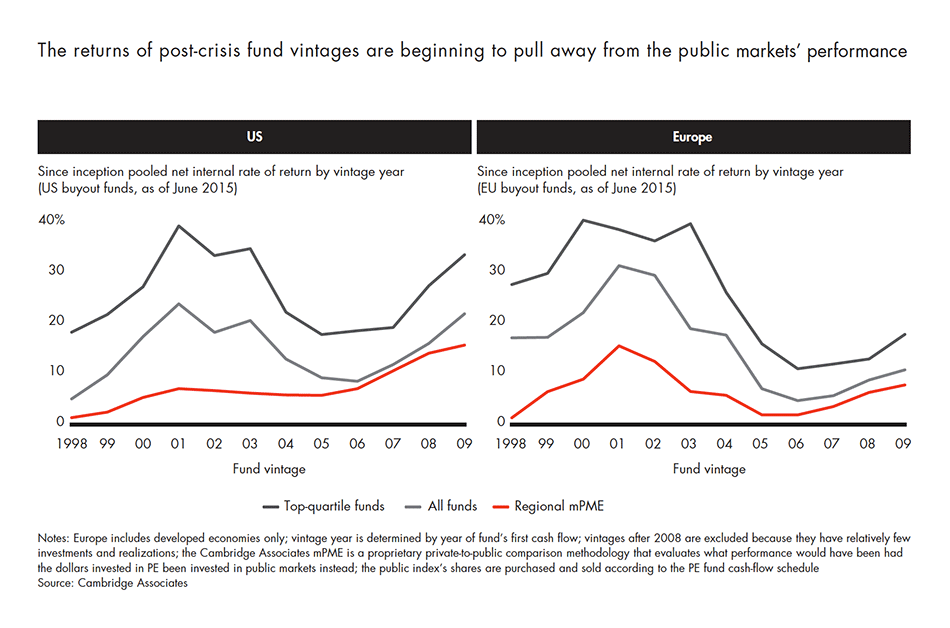Forbes.com
This article originally appeared on Forbes.com.
The period immediately following the 2008 global financial meltdown was a time of anxiety about private equity’s ability to deliver market-beating returns. General partners (GPs) had paid peak prices prior to the crash to acquire the assets held in their portfolios and rushed to mark them down sharply to their much lower prevailing market value. They put exit plans for their mature assets on ice and stretched out holding periods as they waited for the crisis to pass.
But as we explain in Bain & Company’s Global Private Equity Report 2016, PE returns have recovered their footing. Both short- and long-term results reflect PE’s restored luster and GPs’ justifiable claims to have been prudent stewards of their investors’ capital. In particular, it has been PE’s proven capacity to outperform over the long term that has made it the preferred destination for investment capital from limited partners (LPs). According to the most recent data, PE’s 10-year returns to large public pension funds outpaced the S&P 500 by 3.7% net of fees. As the legacy effects of the financial crisis retreat further into the past, PE should consistently perform at a level close to or above public equities over one-, three- and five-year time horizons as well—as buyout funds are currently doing in all major regions of the world.
While market recovery has led to a general uptick in returns of funds since the 2005 and 2006 vintages that bore the brunt of the economic downturn, returns data for the 2008 and 2009 vintages now coming to fruition suggests that PE performance is again beginning to pull away from the performance of public markets. Top-quartile funds have widened their lead in returns by an even greater margin (see figure).

Comparing successive buyout vintages between 2006 and 2008 reinforces the conclusion that fund returns are trending higher over time. The median IRR, both realized and unrealized, of all three fund vintages took a big hit when the markets tanked from late 2007 through the end of 2008, as GPs wrote down the net asset values of holdings in their portfolios. And all have recovered with the strengthening of public equities markets by the end of 2010. Yet the strength of their rebound followed different trajectories. The median IRR of the 2006 vintage buyout funds was up to 9% by the middle of 2015, while the 2007 funds rose to 10%. Meanwhile, the median IRR of the 2008 funds climbed to 12%. Median top-quartile fund returns followed much the same track—up to 17% for the 2006 vintage, 20% for the 2007 vintage and 24% for the 2008 vintage.
As healthy as PE returns were over the past three years, PE’s vulnerabilities to an economic slowdown and the simple reality that the PE industry has matured should temper investors’ expectations that returns will remain as strong as they have been. With GPs now paying premium prices for assets and the chance of recession looming on the horizon, the risk remains that PE investors will see future waves of downward revaluations and a convergence of PE and public market returns.
Ultimately, future PE returns will depend on the skills and foresight of GPs to manage their portfolios proactively in order to withstand market turmoil. Every crest of every wave in the PE cycle is an opportunity for GPs to demonstrate their ability to outperform. GPs have embedded many lessons they learned from the past downturn into their new investment discipline. They are exercising caution when paying high multiples for acquisitions and taking care in their use of debt, which can just as easily eat into returns as enhance them. For now and over the next year or two, GPs and LPs should continue to enjoy the fruits of that dearly acquired wisdom.
Hugh MacArthur, Graham Elton, Dan Haas and Suvir Varma are leaders of Bain & Company’s Private Equity Group.
Carl Evander is a principal in Bain’s Private Equity Group.
